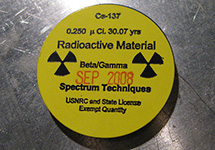Miles Pomper
Egle Murauskaite
Tom Coppen
March 13, 2014
Occasional Paper #19
Read the full Occasional Paper #19:
Alternatives to High-Risk Radiological Sources: The Case of Cesium Chloride in Blood Irradiation
Securing Radiological Sources
There is growing global awareness of the need to secure radiological sources in order to prevent terrorists from using such materials in a radiological weapon, such as a “dirty bomb.” A new CNS report calls for a move towards permanently reducing this threat by substituting non-isotopic alternatives for these sources in civil uses. As an initial step, the authors propose a move towards gradual phase-out of cesium chloride use in pre-transfusion blood irradiation on a global scale – a domain where non-isotopic alternatives are considered to be the most viable in the short-term. They urge United States to launch an international initiative involving the phase out of cesium-chloride and other high-risk radiological sources as a “gift basket” for the upcoming 2014 Nuclear Security Summit.
Cesium chloride is one of the most commonly used radiological materials, despite being an IAEA Category 1 “extremely dangerous” source. Because cesium chloride is easily dispersible, water soluble, and relatively easy to handle, it is particularly suitable for terrorist purposes. The blood irradiators that use it as a source are located in many large hospitals and blood banks (inherently publicly accessible spaces), and the source is usually transported through regular civilian infrastructure at the beginning and the end of its lifecycle, giving more cause for concern.
Cesium chloride based irradiators are used to treat blood and blood products prior to transfusion in order to prevent a rare but fatal Graft Versus Host Disease (GVHD). A growing number of non-isotopic alternatives are becoming available for that purpose, but there is a serious lack of awareness about the range of options and how they compare to current practices, both among the medical professionals and national regulators.
Alternatives
The report surveys several such alternatives: blood irradiators using X-rays as a source, photochemical treatment of blood components with UV-A light, and utilizing linear accelerators (LINACs) that many hospitals have in use for cancer treatments. Indeed, many European governments are already increasing their reliance on these alternative technologies and Japan has been relying on X-ray irradiators as the primary blood treatment since 2000, leaving U.S. the largest market for cesium chloride based irradiators.
The authors urge the US and other governments to use a set of push and pull incentives to encourage a gradual transition away from the use of radiological sources, gathering momentum and promoting research for potential avenues of change in other commercial domains. Such measures include introducing mandatory insurance requirements for the facilities using this highly risky source, non-issuance of new licenses and non-licensing of old cesium chloride irradiators, and assistance in arranging for disposal of disused radiological sources.

